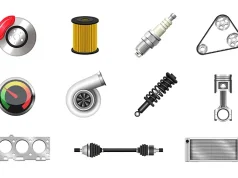
Pickup trucks make exceptional overland adventure vehicles. Their ability to haul gear, traction for off-roading, and home-away-from-home camper options create endless possibilities for exploration. Follow this guide to outfit your pickup and hit the road for epic, memory-making excursions near and far.
When prepping your Ford F150 salvage yard-sourced pickup for travel and camping, the first priorities are protection, storage solutions and amenities to support self-sufficient journeys. While elaborate modifications look flashy, focus first on utility, clearance and essential gear to enable worry-free off-grid travel.
Outfitting Your Pickup for Adventure
Turning your pickup into a long-haul adventure machine requires some smart upgrades for gear hauling, organization, and living requirements while on the go.
Truck Bed Storage
The open bed offers lots of hauling room but little protection or organization. Truck bed covers like retractable roll tops or folding lids secure gear from weather and theft while still allowing quick access. Toolboxes or slide-out storage drawers like those from Decked create a place for everything. Cargo racks carry bikes, kayaks or other large items the box won’t hold. Soft rooftop carriers are also useful for bulky gear. Take stock of what equipment you need to carry, then select storage solutions to keep it all organized and secure.
Camper Shell or Slide-In Camper
For shelter and living space, choose between a basic truck camper shell or a fully outfitted slide-in camper unit. Camper shells are rigid caps that span the bed, typically made of fiberglass or aluminum. They offer lockable, weatherproof space for sleeping and storage over the truck bed. Basic shells start under $1,000, while higher-end versions add screened windows, storage racks and electrical hookups. Slide-in truck campers range from basic pop-ups to large units with hard walls, beds, stoves, plumbing and air conditioning like those made by Lance or Host. Weigh your truck’s payload capacity when deciding between a shell or slide-in, as the larger units can approach 2,000 pounds.
Suspension, Armor and Traction Upgrades
Upgrading suspension improves load handling, ride quality and clearance for traversing rough terrain. Add or upgrade to heavier leaf spring packs, air bags or coil-over shocks designed for hauling and towing heavy loads. Increase wheel articulation and cushioning for off-road use with long-travel suspension kits. Add skid plates, differential covers and other armor to protect vital driveline components from impacts on rocky trails. Increase traction with aggressive all-terrain tires in a size matched to your truck, such as LT285/75R18 for a Ford F150. Plus-size tires and good treads flex through sand, mud and snow far easier than street rubber.
Power and Lighting Solutions
For long trips off the grid, add an auxiliary fuel tank like those from Transfer Flow to increase driving range between fill-ups. Upgrade to heavier alternators and batteries, or opt for a hardwired dual battery setup to run accessories without draining the starting battery. Kits from companies like Odyssey integrate a secondary battery solely for accessories. For illuminating trails at night or early mornings, add powerful LED off-road light bars and pods on your roof, bumper or grill.
Camping Accessories
Deck out your pickup with awnings and tents for shade and sleeping quarters. Soft-shell popup tents by brands like Tuff Stuff install over truck beds for quick camping. Hard-shell rooftop tents flip open to sleeping space high above the truck. Portable stoves, refrigerators, showers, toilets and water tanks enable camping off-grid. Carry plenty of water and fuel, and stock food that requires no refrigeration. Bring tools, spare fluids, recovery gear and any other items required to handle vehicle repairs yourself when deep in the backcountry.
Top Long-Haul Road Trip Routes
When it’s time to hit the road for weeks or months of adventure, countless amazing routes across North America await. Gear up your Ford F150 or other pickup properly, then take your pick of these remarkable overland journeys.
Alaska-Canada Highway
This epic drive from Dawson Creek, British Columbia ends 1,387 miles later in Delta Junction, Alaska. Pass through rugged wilderness, sub-arctic forest and the Yukon river valley en route. Stop in towns like Fort St. John, Fort Nelson, Watson Lake and Whitehorse to resupply, then cross into the Yukon Territory. Towns become fewer but landscapes ever more spectacular as you continue north through Tok and across the Alaska border. Glacier-capped mountains, tundra and boreal forest await before reaching Delta Junction. Allow 2-3 weeks for a complete drive, spending time exploring incredible side roads and trails along the route.
Dempster Highway, Yukon
Travel from Dawson City, Yukon to Inuvik, Northwest Territories on this remote dirt highway traversing tundra and crossing the Arctic Circle. Pass abandoned mining towns, roadhouse lodges open in summer, and road-accessible Tombstone Territorial Park, one of Canada’s hidden gems. Herds of caribou and moose, vivid Aurora Borealis displays in winter, and the midnight sun in summer provide unique sights. Give your Ford F150 skid plates and heavy suspension to handle the rough road conditions. Plan at least 10 days for the 500+ mile drive, plus side excursions.
Thelon River Run, Northwest Territories
Accessible only a few months a year when ice melts, this challenging 200-mile route follows the Thelon River through the Canadian arctic tundra. Launch via float plane from Yellowknife or Fort Smith for a true adventure. Self-sufficiency is an absolute must with no towns or facilities, but the excellent fishing and stark scenery are incredible rewards. Drive cautiously over rocky terrain, gearing up with puncture-resistant tires and extra fuel. 14 days provides time to savor this remote drive.
Utah’s Highway 12
Named one of America’s most scenic drives, this 124-mile stretch through red rock country hits Capitol Reef and Bryce Canyon national parks. Pass through Grand Staircase-Escalante and Dixie Forest Monument regions as well. The road carves through steep canyon walls, traversing switchbacks and grades exceeding 16%. Climb over mountain passes, then dip into valleys dotted with cottonwoods and skirting blues lakes. Allow a week to also explore parks, slot canyons and other natural wonders accessible from Highway 12.
California’s Lost Coast
Tackle the challenging gravel and dirt roads along California’s rugged Lost Coast. This rocky, windswept shoreline north of San Francisco was bypassed by the Pacific Coast Highway, remaining isolated and inaccessible other than by 4×4 vehicle. Pass through redwood groves, along sheer cliff edges and secluded beaches for a 100-mile test of truck and driver. Set aside 4-5 days to complete the route, plus enjoy hiking, fishing and beachcombing. Equip your truck properly for the rough road conditions.
The Loneliest Road – US 50 Across Nevada
Traversing Nevada on US 50 is one of America’s most iconic long-haul road trips. Dubbed “The Loneliest Road”, the path stretches over 400 miles between Fernley and Ely, with only a few tiny towns along the way. Take it slow and enjoy the desolate beauty, passing old mining settlements, sprawling ranchlands and the continental divide. Allow 10 days to travel US 50 point to point, circling Great Basin and Lehman Caves parks along the way.
Tail of the Dragon – Deals Gap, NC
Just 11 miles long but legendary, this ribbon of asphalt offers 318 curves through the Appalachian Mountains near the Tennessee/North Carolina border. Drive it for the challenge, but very cautiously, as its reputation draws many reckless speed demons. The scenery racing by is stunning, passing lakes, whitewater rivers, waterfalls and lush mountain greenery. Combine a run over the Tail of the Dragon with exploring Great Smoky Mountains National Park for an epic week-long Appalachian adventure.
Epic Off-Road Trails and Challenges
Once your truck is prepped for the rigors of remote travel, some incredible off-pavement adventures await. Avoid these iconic routes without extensive 4WD experience and preparations.
Rubicon Trail, CA
One of the most iconic and challenging 4×4 trails in North America, the Rubicon Trail winds 22 miles through the Sierra Nevada mountains near Lake Tahoe. Built for 19th century mining access, it deteriorates from hard-packed dirt into a serious 4×4-only route. Take it slow, allowing 2-3 days for the drive. Have spotters and winching equipment for the toughest sections. Must-do obstacles include the “Slab”, “Cadillac Hill”, and “Rubicon Springs”, each requiring meticulous line selection and equipment suited for extreme rock crawling. Time it right to avoid snow at higher elevations.
Hell’s Revenge, Moab, UT
Consistently ranked one of the toughest trails around Moab, Hell’s Revenge requires advanced 4WD skills over steep slickrock. Drive stock trucks very cautiously, as ample clearance, skid plates, rock rails and shock adjustments are musts for tackling it unscathed. Slickrock obstaces loom large with precipitous drop-offs all around, demanding precise line selection. Look for occasional bypasses around the most vehicle-swallowing sections. Allow 2 days to fully experience Hell’s Revenge and adjoining trails like Fins & Things.
Black Bear Pass, CO
Connecting Telluride and Ouray, CO, old mining road Black Bear Pass climbs to 12,840 feet with extreme exposure and terrain. You’ll need a highly modified vehicle and nerves of steel. The narrow track clings to cliffsides with 2,000 foot drop-offs just inches away. Pass dilapidated mining structures and negotiate rocky shelves and ledges where one mistake means certain death for truck and driver. Be prepared for high-altitude conditions and have recovery equipment handy. 2 days provides time to safely experience the intense challenge of Black Bear Pass.
The White Rim Trail, Canyonlands, UT
Circumnavigating the Island in the Sky Mesa, this iconic 100-mile loop provides stunning Canyonlands National Park panoramas. Traverse sandstone slickrock fins and canyons at Shafer Trail. Pass Musselman Arch and Washer Woman Arch, completing the rugged loop to Grand View Point. Reserve campsites in advance and be prepared for deep sand and absolutely no water sources along much of the trail. Allow 4-5 days to leisurely experience the White Rim Trail.
The Trans-Alaska Pipeline, AK
Paralleling the Trans-Alaska Pipeline, this overland route travels through remote Alaskan wilderness from Fairbanks 515 miles south to Valdez. You’ll traverse boreal forest, the frigid Brooks Mountain Range, and wild taiga en route to coastal Valdez. It’s an epic journey to Alaska’s rugged interior accessible only to highly equipped expedition vehicles. Carry extra fuel, spare tires and recovery gear for the harsh conditions. Allow 2-3 weeks for this remote trek through an area most people never experience.
Essential Gear for Truck Camping and Overlanding
Fully realizing your pickup’s overland potential requires packing the right gear for extended, self-sufficient travel through remote regions far from civilization.
Some must-have items for truck camping and overland travel include:
- Rooftop tent or truck bed camper for comfortable sleeping quarters
- Portable power stations like Jackery or Bluetti models to run accessories
- Solar panels and wiring for off-grid power generation
- Water storage and filtration system with pump
- Multi-burner camp stoves plus cooking/eating utensils
- Cooler or portable refrigerator like Dometic models to keep food fresh
- Storage bins, organizers and cargo nets for gear security
- Hi-lift jacks, traction boards, winch and other recovery/extraction tools
- Shovel, axe, saw, hatchet for camp chores and firewood processing
- Heavy-duty suspension, skid plates, rock sliders and armor for off-road protection
- All-terrain tires sized appropriately for your truck (LT285/75R18 ideal on a Ford F150)
- Maps, GPS navigator, satellite communicator/PLB for navigation and emergencies
- CB radio and other communication devices for group travel
- First aid kit enhanced for remote locations
- Fire extinguisher, flares, lanterns and other essential safety items
- Bear spray, wildlife alarms and precautions for animal encounters
- Vehicle tools, fluids, belts, hoses and spare parts for remote repairs
- Quality outerwear, base layers, footwear and sleep kit matched to conditions
With the right preparation, equipment selection and upgrade additions, your pickup can reliably handle any epic journey on the open road or into the backcountry. Use this guide to plan your next overland truck adventure! The freedom of the world’s limitless routes and trails awaits.
Conclusion
A properly equipped pickup truck makes the perfect overland adventure vehicle for extended journeys across diverse terrain. With their ample hauling capability both in the bed and via towing, plus available 4WD traction for off-road travel, trucks can access incredible remote destinations. When outfitted for self-sufficient camping and enhanced with upgrades to protect it from harsh conditions, a pickup can get you far from civilization – and back – with confidence.
The Ford F150 is one of the most popular and proven trucks for overlanding and adventure travel, with excellent payload capacity and modifications available for enhanced clearance, protection, recovery, and living amenities. When trucks like the F150 are turned into road-ready adventure machines using this guide, an epic trip across the continent or into the backcountry becomes reality.
So get out there and outfit your pickup for the journey of a lifetime! Use the tips in this guide to prepare your truck and load it up with all the essential gear. Then get ready for the adventure you’ve dreamed of, exploring the beauty and excitement of North America’s remarkable back roads, trails and scenic routes from Alaska to the Southern US and thousands of miles in between. Your truck and the open road await – time for an adventure!





